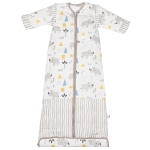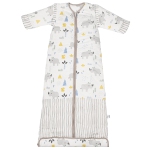Bundle your baby in a sleep sack
What is a sleep sack and what types are available?
Sleep sacks are like mini cocoons for babies, infants, and toddlers. They zip up around baby, either over top their pajamas, fitted cotton shirt and pants, or directly over the diaper to keep baby warm and safe while sleeping. Babies should never sleep with anything in their crib but a fitted sheet, so sleep sacks provide the convenience of a wearable blanket without having to use a loose one.
They come in a variety of colours and styles, from solids to stripes and themes, as well as different materials, from lightweight cotton to thicker microfleece or Sherpa. You can get 0-3 months sleep sacks all the way up to ones suitable for toddlers and kids from 4-5 months, with standard increments in sizing like 6-12 months, 12-24 months, and so on.
They usually have a zipper in the middle that goes from bottom to top for easily changing a diaper in the middle of the night without taking the sleep sack off entirely. Some have holes for arms and legs or you can tuck them inside. Some are sleeveless, others have fitted leg holes and/or short sleeves. Regardless of design, the bottoms are wide enough so if the legs are tucked inside, baby can still freely move their limbs about.
What is the difference between a sleep sack and a swaddle?
While sleep sacks and swaddles both help safely keep a baby warm and cozy while sleeping, they employ different designs.
A sleep sack zips baby into their own wearable blanket, almost like a sleeping bag. A swaddle, meanwhile, wraps snugly around the baby to mimic the feel of being in the womb. The purpose of a sleep sack is to keep baby warm without a loose blanket while still being able to move their limbs. A swaddle, on the other hand, is better suited to newborns and small babies, keeping the arms and legs tucked away so the baby can't startle themselves awake. While you can swaddle with a standard baby blanket, it's much easier with a swaddle that takes the guesswork out of the folding technique.
Once a baby is dextrous enough to get out of a swaddle and is ready to stretch those arms and legs, it’s time to move on to a sleep sack.
What should you look for in a sleep sack?
Consider the material of the sleep sack as well as the TOG value, a unit of measure that advises how warm a sleep sack will keep your baby. Cotton, for example, might have a 1.0 to 1.5 TOG sleep sack rating while microfleece can be from 1-3. This is useful not only to decide what material to get but also what to put on your baby underneath in order to prevent overheating.
For winter, a thicker fabric like fleece or Sherpa with a thin onesie underneath might suffice while in summer, you might want to go for cotton and put the sleep sack on over just the diaper.
Look for soft and breathable fabric that can wick away moisture. Check that the zipper opens and closes easily and a piece of material at the top secures the zipper pull. Make sure there's enough room at the bottom for your baby to move their legs around if you get one without fitted leg holes. And choose the right size – a large sleep sack is gives baby extra room to stretch their limbs and for their skin to breath, especially when a sleep sack is on over clothes.
What are the Benefits of Baby Sleep Sacks?
When it comes to nap time and bedtime, baby sleeping bags are the way to go. Here are some reasons why.
Safe for Sleeping
Loose bedding in cribs can pose a serious threat to babies, as they increase the risk of suffocation and sudden infant death syndrome (SIDS). Sleep sacks are a safe, comfortable alternative to baby blankets because they fit securely around your baby without the risk of covering their face. They offer enough room for babies to comfortably move their limbs but can’t be kicked off.
Keeps Baby Warm Without Overheating
Sleep sacks are designed to be worn over baby’s usual sleepwear. They’re sleeveless to keep your baby comfortable and covered without overheating. On warmer days, consider a sleep sack made of lightweight, breathable material like cotton. On cooler days, use a sleep sack made with warmer material like micro-fleece or sherpa.
Travel-Friendly
Like a piece of clothing, a baby sleeping bag is easy to fold and pack for quick road trips and extended holidays. Sleeping sacks are like a safe, familiar cocoon for little ones to sleep in – even when they’re not in their own crib.
Makes Diaper Changing Easy
Sleep sacks have a zipper down the middle, making it a cinch to take them on and off your baby. But, the unusual (and smart) thing is, these zippers are upside down – zipping open from bottom to top. This lets you change your wee one’s diaper without removing the sleep sack. It also prevents curious little hands from unzipping the sleep sack open.



